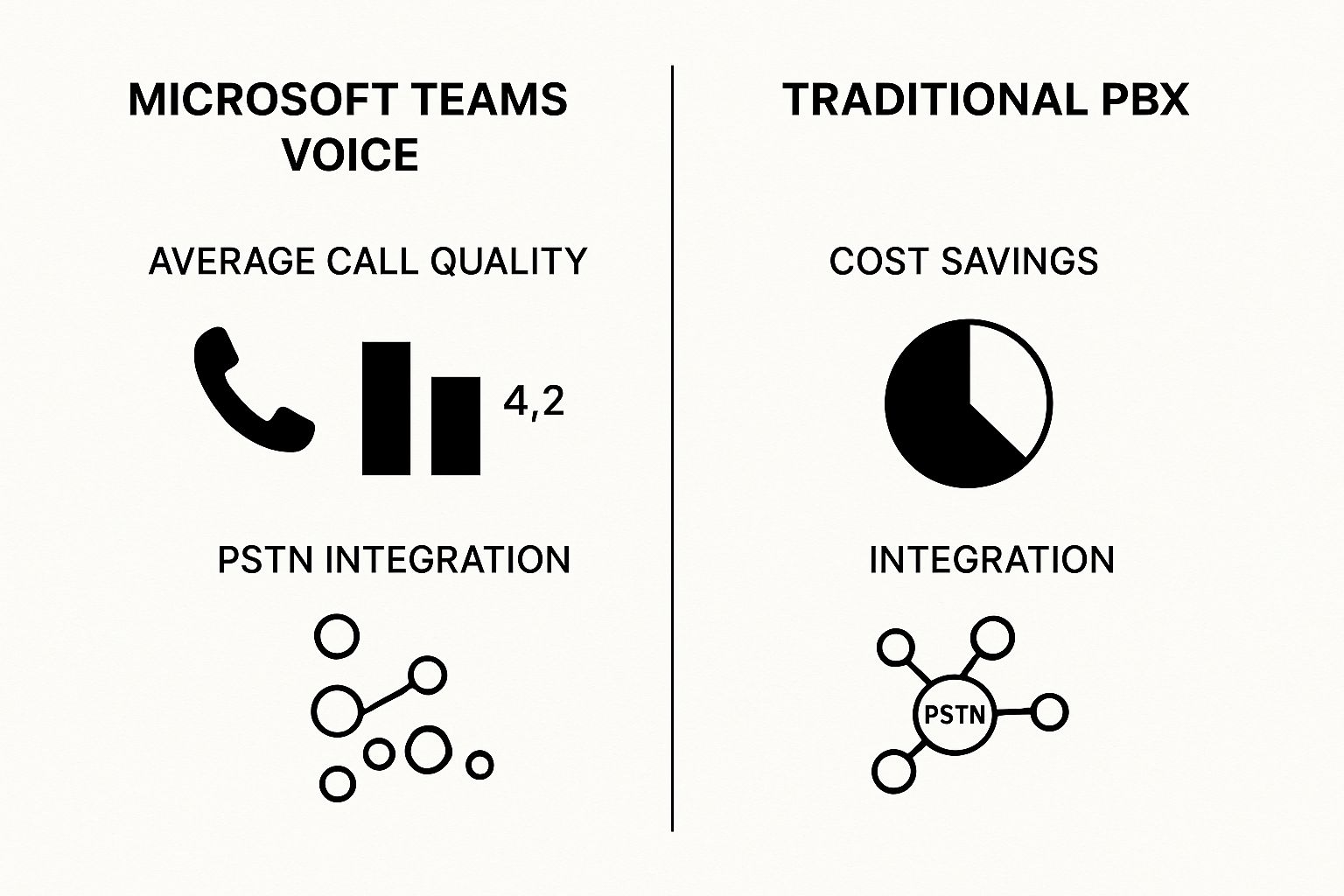You've probably been using Microsoft Teams for a while now for chats, file sharing, and video meetings. But what if it could completely replace your office phone system? That's exactly what Microsoft Teams Voice does. It’s the feature that turns your familiar Teams app into a full-blown, cloud-based business phone system.
This isn't just about adding a dial pad. It means your team can make, receive, and transfer calls to and from landlines and mobile numbers anywhere in the world, all from the same Teams interface they already know. Essentially, it lets you say goodbye to that clunky old Private Branch Exchange (PBX) hardware in the server closet and move everything into a single, software-driven platform.
What Is Microsoft Teams Voice and Why It Matters in the UAE

Think of Teams Voice as the central hub for every conversation your business has. It’s not just another app; it’s the piece that connects your internal collaboration with your external customer calls. Imagine finally getting rid of the traditional desk phone—that device tethered to a wall—and replacing it with a powerful, integrated tool that works seamlessly on an employee’s laptop, tablet, or smartphone.
This is a massive step forward, especially for businesses here in the UAE. With the strong push toward digital transformation and the reality of hybrid work, having a disjointed communication system just doesn’t cut it anymore. Teams Voice offers a way to bring every conversation, whether it's with a colleague or a client, into one secure and manageable environment.
The Shift to Unified Communications
The move to platforms like Microsoft Teams Voice is part of a much bigger trend: the shift away from siloed tools toward a single source for all business communication. Instead of juggling a desk phone for external calls, a mobile for when you're on the go, and a separate app for team chat, everything is brought together. This is the core idea behind Unified Communications as a Service (UCaaS), a model that's rapidly gaining traction.
In fact, the UCaaS market in the Middle East and Africa is projected to grow at a compound annual growth rate (CAGR) of about 14.7% between 2023 and 2030. This growth is a direct result of businesses realizing the powerful efficiencies gained by unifying their communication stack.
A truly unified system means an employee can start a chat on their laptop, escalate it to a voice call, and then seamlessly transfer that call to their mobile device as they leave the office—all without interruption.
Key Benefits for UAE Businesses
For any organization operating in the fast-paced UAE market, the benefits of adopting Microsoft Teams Voice are tangible and immediate. This is less about simple convenience and more about building a more agile, efficient, and future-proof business.
To give you a clearer picture, here’s a quick summary of what makes Teams Voice such a compelling choice for businesses.
Microsoft Teams Voice at a Glance
| Functionality | Description | Business Benefit |
|---|---|---|
| Cloud PBX | A complete set of call control features like call forwarding, voicemail, and auto attendants, all hosted in the cloud. | Eliminates the need for expensive, on-premises phone hardware and simplifies IT management. |
| Direct Inward Dialing (DID) | Assigns a unique phone number to each user, allowing external parties to call them directly on Teams. | Makes employees easily reachable and projects a professional, established presence. |
| Unified Presence | A single status (Available, Busy, In a Call) is shared across chats, meetings, and phone calls. | Reduces interruptions and makes it easy to know the best way to contact a colleague at any moment. |
| Call Queues & Auto Attendants | Automatically route incoming calls to the right department or individual using custom menus and greetings. | Improves customer experience by directing callers efficiently without manual intervention. |
| Cross-Device Functionality | Make and receive calls seamlessly on any device with the Teams app—desktop, web, or mobile. | Enables a truly mobile workforce, ensuring no important calls are missed, regardless of location. |
By bringing these core communication functions under one roof, you create a more connected and productive work environment. For organizations in the UAE, making this switch is a strategic move to stay competitive, responsive, and ready for whatever comes next.
Choosing Your Path: Calling Plans vs. Direct Routing
Once you've decided on Teams for your business calls, the next big question is how you’ll connect it to the outside world. This isn't just a technical detail; it's a strategic choice that shapes your costs, flexibility, and day-to-day management. You have two main paths to take: Microsoft Calling Plans or Direct Routing.
Think of it like this: you can get your TV service as a simple, all-in-one package from a single provider, or you can pick and choose your streaming apps to build a custom entertainment setup. Both get you the shows you want to watch, but they offer very different levels of simplicity and control. That’s the core difference here. The right path for your business in the UAE really boils down to what you value most—convenience or customization.
Understanding Microsoft Calling Plans
Microsoft Calling Plans are the simplest, most direct way to get your team making and receiving external phone calls. In this setup, Microsoft is your all-in-one telephone company. They provide the phone numbers and a bundle of calling minutes for each user, all managed neatly within your Microsoft 365 account.
This is the "set it and forget it" option. The biggest advantage is how fast and easy it is to get started. You can literally have your team up and running with phone numbers in a matter of hours, all handled through the familiar Microsoft 365 admin center. No complex hardware, no separate phone bills.
This approach is a great fit if your business:
- Wants a fast, straightforward deployment with minimal IT fuss.
- Is located in a region where Microsoft directly offers these plans.
- Has fairly predictable calling needs that fit neatly into a bundled-minute package.
- Loves the idea of a single vendor for billing and support.
For many small and medium-sized businesses without a dedicated telephony specialist on staff, the sheer simplicity of Calling Plans is a game-changer. It takes all the guesswork out of setting up a business phone system.
Exploring the Flexibility of Direct Routing
Direct Routing is the power-user option. It operates on a "bring your own carrier" model, which means you can connect Microsoft Teams to just about any phone provider on the planet. Instead of Microsoft acting as your carrier, you get to choose your own, like a major local provider here in the UAE.
So, how does that connection actually happen? It relies on a key piece of technology called a Session Border Controller (SBC). You can think of the SBC as a secure translator or a bridge. It sits between your chosen carrier's network and your Microsoft Teams setup, ensuring that all call traffic flows smoothly, securely, and reliably between the two.
Direct Routing gives you ultimate control. You aren't just a customer of a service; you become the architect of your own communications infrastructure. This means you can negotiate your own call rates, integrate with older phone equipment, and design call routing rules tailored precisely to your business processes.
This path is the go-to solution for organizations with more complex needs. For instance, if you’re planning a gradual move away from an old on-premise PBX, or if you have offices in countries where Microsoft’s plans aren’t available, Direct Routing is your answer. It opens up a world of customization and potential cost savings that you just can't get with the standard plans.
This infographic shows just how a modern solution like Microsoft Teams Voice stacks up against traditional PBX systems on key metrics like call quality and cost-effectiveness.

As the data shows, moving to Microsoft Teams Voice can lead to much better call quality and significant cost reductions compared to legacy, hardware-dependent phone systems.
Comparison of Calling Plans and Direct Routing
Deciding between these two options is really a trade-off between simplicity and control. To make the choice clearer, let's put them side-by-side and see how they stack up.
| Feature | Microsoft Calling Plans | Direct Routing |
|---|---|---|
| Carrier | Microsoft is your sole carrier. | You choose your own carrier (e.g., local UAE providers). |
| Contracts & Rates | Fixed per-user, per-month fees and minute bundles from Microsoft. | You negotiate rates and contracts directly with your chosen carrier. |
| Global Reach | Limited to countries where Microsoft offers PSTN services. | Global. Connect to any carrier worldwide. |
| Hardware | No on-premise hardware required beyond user devices. | Requires a certified Session Border Controller (SBC). |
| Technical Expertise | Minimal. Managed through the Microsoft 365 admin center. | Requires specialized expertise in telephony and SBC management. |
| Flexibility | Low. Limited to the features offered by Microsoft. | High. Allows for complex call routing and legacy system integration. |
For businesses in the UAE, the ability to use a local carrier’s strong network and competitive pricing is a major draw for Direct Routing. To see how this works in practice, it’s worth exploring the details of an Etisalat SIP Trunk solution, a common building block for these kinds of deployments.
In the end, your choice should align with your business strategy. If you need a phone system that's quick, simple, and managed all in one place, Calling Plans are an excellent choice. But if your organization requires greater flexibility, cost control, and a global footprint, then making the investment in Direct Routing will pay off significantly in the long run.
Decoding Microsoft Teams Voice Licensing and Costs

Trying to get your head around the licensing for Microsoft Teams Voice can feel a bit like putting together a puzzle at first. But the best way to think about it is like assembling a set of building blocks. Microsoft designed it to be modular, so you only pay for the specific pieces your business actually needs.
Everything starts with your base Microsoft 365 or Office 365 license. This is the foundation that includes the Teams platform itself—the ground floor for your new voice solution. If you're on a common business plan like Business Standard, Business Premium, or Enterprise E3/E5, you're already set.
The next critical block to add is the Teams Phone add-on license. This is the key that turns on the engine. It activates the core Private Branch Exchange (PBX) features, transforming Teams from a great collaboration app into a full-fledged business phone system.
Core Licensing Components
Once that foundation is solid, you can add the components that give you full calling capabilities. From here on, your costs and the structure you choose will depend entirely on how you connect to the Public Switched Telephone Network (PSTN)—either with Microsoft's own Calling Plans or through Direct Routing.
Let's unpack the essential pieces you'll need to budget for:
- Base Microsoft 365/Office 365 License: This is your entry ticket, giving you access to the Teams platform.
- Teams Phone Add-on: This one is non-negotiable for voice. It unlocks all the phone system features you'd expect, like call hold, transfers, voicemail, and call queues.
- PSTN Connectivity: This is your line to the outside world. The cost here is for either a Microsoft Calling Plan or the services from your Direct Routing carrier and any related hardware.
This layered approach is actually a good thing. It lets you build a financial plan that mirrors your operational reality, ensuring you aren't stuck paying for features you'll never use.
Understanding Additional Costs
Beyond the main licenses, a few other potential costs are worth keeping in mind to create a complete and transparent budget. You won't always need them, but for certain business functions, they're essential. Overlooking them can lead to some unwelcome surprises on your bill.
One of the most common is Communications Credits. The easiest way to picture this is as a pay-as-you-go wallet for your Teams account. It's there to cover charges that fall outside your standard calling plan subscription.
Think of Communications Credits as a financial safety net. They ensure your business never drops a call just because you have a toll-free number or a user needs to make a few extra international calls. It’s a small but vital piece for keeping things running smoothly.
For instance, you'd dip into these credits for things like:
- Toll-Free Numbers: To cover the per-minute charges when customers call your 800-numbers.
- International Calls: For when a user on a domestic-only plan needs to call a client overseas.
- Overage Minutes: If someone with a bundled plan happens to go over their monthly minute allowance.
And if you go down the Direct Routing path, you absolutely must factor in the cost of your Session Border Controller (SBC) and the monthly fees from your chosen telecom provider. These are central to budgeting for a Direct Routing deployment. By understanding these building blocks—the base license, the Phone add-on, your connectivity choice, and any credits—you can put together a precise and predictable budget for your entire Microsoft Teams Voice solution, no surprises included.
How Core Features Replace Your Traditional Phone System
Making the switch to Microsoft Teams Voice isn't just about unplugging an old phone and plugging in a new one. It’s a genuine upgrade to your entire communication fabric. You're moving past a simple dial tone and embracing a set of intelligent tools that make traditional desk phones feel like relics from a bygone era. The platform is built to solve real-world business problems, whether that's managing a flood of incoming calls or just making sure the right message gets to the right person, every single time.
This shift isn't just a concept; it's happening right now across the UAE. Microsoft Teams adoption has soared as businesses have adapted to new ways of working. Back in early 2020, for example, the Middle East and Africa saw a staggering 8.6 million downloads of Teams. Professionals were spending over 10 hours a week in virtual meetings, which really underscores how central the platform has become. You can dig into more of this data and its impact by looking at recent statistics on Microsoft Teams usage.
These aren't just flashy bells and whistles. They are practical tools designed to break down the daily communication barriers that slow businesses down, boosting both efficiency and the customer experience.
Intelligent Call Management Tools
Think of it like having a digital receptionist who's on duty 24/7 and never needs a coffee break. That’s the magic of an Auto Attendant. It greets every single caller with a polished, custom message and gives them a simple menu to get where they need to go—"Press one for sales, press two for support." It’s professional, efficient, and ensures no one gets lost in the shuffle.
And what about teams that are constantly swamped with calls, like your sales reps or customer service agents? That's where Call Queues come in. Instead of a frustrated caller hitting a busy signal, they’re placed into an orderly queue. They can listen to music or customized announcements until the next person is free. It’s a simple but powerful way to make sure you never lose a potential lead or an important support call just because all your lines were busy.
User-Centric Features for Modern Work
The real power of Microsoft Teams Voice also shines through in the features designed for individual employees. It’s built with the understanding that work isn't confined to a single desk anymore.
- Seamless Call Transfers: Effortlessly pass a call to a colleague with a couple of clicks, whether they're in the next office or working from a café across town. You can even have a quick, private chat with them before you hand off the call.
- Voicemail Transcription: Missed a call? No problem. Teams automatically converts the voicemail into text and sends it straight to your email and the Teams app. This lets you scan the message in seconds to see what’s important, without having to stop what you’re doing to listen.
- Simultaneous Ringing: Set up your calls to ring on all your devices at once—your desk phone, your laptop, and your mobile. It gives you the freedom to answer important calls no matter where you are.
These tools are at the heart of what makes Voice over IP in Dubai and other regions so valuable, offering a level of flexibility that older systems just can't touch.
By bringing all these functions together, Teams Voice eliminates the friction in day-to-day communication. It delivers a single, cohesive system that molds to your workflow, instead of forcing you to work around its limitations. This consolidation is the key to elevating both internal productivity and the quality of your customer service.
Powerful Analytics and Insights
One of the biggest leaps forward from an old PBX system is the access to data. The Teams Admin Center gives you a clear window into your organization’s calling patterns and quality. Administrators can watch call quality in near-real-time, get ahead of potential issues, and analyze usage data to make smarter decisions about resources. For instance, if you see that your support queue is constantly slammed between 2 and 4 p.m., you know you might need to schedule more agents for that block of time.
This kind of visibility is essential for maintaining high service standards and keeping costs in check. To get a better sense of how Teams Voice compares to other options on the market, it’s worth checking out some of the top small business phone systems to see where it stands.
Ultimately, these core features combine to create a communication ecosystem that’s smarter, more flexible, and far more insightful than any traditional phone system could hope to be.
Best Practices for a Smooth Migration and Adoption

Rolling out Microsoft Teams Voice successfully hinges on more than just flicking a technical switch; it's about empowering your people. The real goal isn't just to implement a new system, but to get your team to genuinely embrace it. This requires a smart, human-centric roadmap that covers technology, strategy, and most importantly, your users' experience.
Before you do anything else, you have to check your foundation. A network readiness assessment is absolutely non-negotiable. Think of it as surveying the land before building a house. This process stress-tests your internal network to make sure it can handle real-time voice traffic without annoying issues like jitter or packet loss, ensuring every call is crystal-clear from day one.
Once you’re confident your network is up to the task, you can map out the actual rollout. You don't have to move everyone over at once. In fact, most organizations find a more gradual, phased approach works best.
Plan Your Rollout Strategy
A methodical rollout minimizes chaos and gives your IT team the breathing room to manage the transition smoothly. It’s all about picking the approach that best fits your company's culture and daily operations.
- Pilot Group First: Start small. Give Teams Voice to a select, tech-friendly group of users. This creates a safe sandbox where you can iron out any kinks before they impact the entire organization.
- Department-by-Department: Roll out the system one department at a time. This approach contains the learning curve and lets you gather incredibly specific feedback from unique user groups, like your sales team or customer support agents.
- Full Cutover: For smaller, more agile businesses, a "rip and replace" approach over a weekend can be effective. It gets everyone on the new system fast, but be warned: this method demands meticulous, down-to-the-minute planning.
Whichever path you choose, communication is the glue that holds it all together. Keep everyone in the loop on the timeline and what they should expect.
Drive User Adoption and Training
A new tool is only as good as the people using it. The single most important part of this entire process is user adoption. Just dropping a new icon on their desktop isn’t enough; you have to show them why it's better and help them feel comfortable with the change.
As of 2024, Microsoft Teams Phone continues to expand its presence in the UAE and throughout the Middle Eastern market, becoming a serious competitor to traditional phone providers. For many businesses in the UAE, it's now the go-to cloud phone system, thanks to Microsoft's trusted name. This widespread adoption makes it even more crucial that your staff feels confident using it.
The ultimate goal is to move users from "having to use" Teams Voice to "wanting to use" it. This happens when they personally experience how it simplifies their workday and improves communication with colleagues and clients.
To get there, you need to build a solid support system:
- Develop a Strong Training Program: Don't do one-size-fits-all training. A salesperson's needs are completely different from an admin's. Build your sessions around real-world scenarios, not just a dry list of features.
- Create Internal Champions: In every department, find those enthusiastic users who "get it" and deputize them as go-to resources. These champions offer priceless peer-to-peer support and build positive momentum from within.
- Provide Quick-Reference Materials: No one remembers everything from a training session. Resources like the official Microsoft Teams Handbook can be lifesavers. Having cheat sheets and guides readily available encourages people to find their own answers.
- Communicate the "Why": Never stop explaining the benefits. Show them how features like voicemail transcription and simultaneous ring can save them time and prevent missed client calls. Connect the dots between the technology and their daily wins.
By focusing on a solid network, a strategic rollout, and a dedicated push for user adoption, you can ensure your move to Microsoft Teams Voice isn't just a project, but a true success that unlocks a new level of collaboration.
Frequently Asked Questions About Teams Voice
Whenever a business thinks about moving to a new phone system, a lot of questions pop up. It's only natural. Here, we’ll tackle the most common ones we hear about implementing Microsoft Teams Voice to give you a clearer picture of what the switch actually involves.
Can I Keep My Existing Business Phone Numbers?
Yes, absolutely. Keeping your current phone numbers is a standard, and frankly, critical part of any successful migration. The industry term for this is 'number porting'.
No matter which path you take—the all-in-one simplicity of Microsoft Calling Plans or the greater control of Direct Routing—your established business numbers come with you. This is key for business continuity. Your clients, partners, and suppliers can keep calling the same numbers they’ve had saved for years.
For those of us in the UAE using Direct Routing, you'll work directly with your chosen local telecom partner, who will handle the porting process and make it a seamless transition.
What Kind of Hardware or Phones Do I Need?
This is one of the best parts about Microsoft Teams Voice: you have options. Your team isn’t stuck with one type of device, so you can pick the hardware that makes the most sense for how they actually work.
Here’s how most people make and take calls:
- Softphone: Using the Teams app on a computer with a good quality headset is the most common setup.
- Mobile App: The Teams app on a smartphone gives you a full-featured business line in your pocket.
- Desk Phones: For those who prefer a traditional handset, there are dozens of Teams-certified desk phones from trusted brands like Yealink, Poly, and Crestron.
- Conference Devices: You can also get specialized hardware for meeting rooms of all sizes.
This flexibility means you can outfit your team based on your budget and what they need to be productive, without getting locked into a single hardware vendor.
Security is a foundational element of the platform, not an afterthought. Every aspect of Microsoft Teams Voice is protected with enterprise-grade security measures to safeguard your business communications.
Is Microsoft Teams Voice Secure for Business?
Yes, it’s built from the ground up with security in mind. All communications within the Teams platform, including every voice call, are protected by strong encryption, both while the data is moving across the network and when it’s stored.
Teams Voice also inherits the powerful security and compliance framework of the entire Microsoft 365 ecosystem, which is a huge advantage for meeting strict regulatory standards. If you go with Direct Routing, the certified Session Border Controller (SBC) you deploy acts like a security guard for your voice traffic, adding another tough layer of protection.
How Does Call Quality Compare to a Traditional Phone Line?
When everything is set up properly, the call quality on Microsoft Teams Voice is consistently excellent. In fact, it often delivers high-definition (HD) audio that sounds noticeably clearer and richer than a standard analog phone line.
Of course, the quality is tied directly to your internet connection's stability and bandwidth. The good news is that Microsoft gives your IT team powerful tools, like the Call Quality Dashboard (CQD), to keep a close eye on performance. They can spot trends and fix potential network hiccups before your users even notice a problem, ensuring every call sounds professional.
Ready to transform your business communications with a secure, flexible, and fully integrated solution? Cloud Move specializes in deploying Microsoft Teams Voice with Direct Routing, tailored to your unique needs. Connect with our experts today for a free demo and discover how we can unify your communications.




